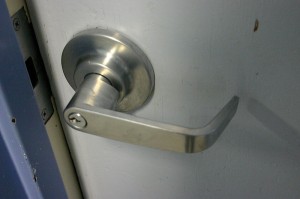When selecting door hardware for your project, it may not be as straight-forward as going to your local hardware store and grabbing the first door knob and lock set that you see on the shelf. For the sake of simplicity, I will just be focusing on the most basic, door handle and lock portion that makes up the majority of door hardware. There are actually rules and regulations that govern what type of door hardware may be used in certain applications. While there are not many restrictions placed on door hardware for single family residences, there are very different guidelines for almost all other construction types, mostly related to accessibility as governed by The American National Standards Institute (ANSI), the Americans with Disabilities Act (ADA), and the Builders Hardware Manufacturers Association (BHMA), all of which I will get back to in a moment. Door hardware is also designed for different use cycles (how many times the door is expected to be operated in a given period of time). BHMA classifies, tests, and certifies three different grades of door hardware:
Grade 1:
• Designed for 800,000 life cycles and must be able to resist an applied force of 300 inch-pounds.
• Most common in commercial settings
• Provides the highest level of security among the 3 grades
Grade 2:
• Designed for 400,000 life cycles and must be able to resist an applied force of 150 inch-pounds.
• Used for both residential and commercial settings requiring decreased security (such as an internal locking door to an individual room or office)
Grade 3:
• Designed for 200,000 life cycles and must be able to resist an applied force of 120 inch-pounds.
• Most common in residential use
• This is the least durable of the grades and, generally, is restricted to use in residential applications.
In terms of accessibility, there are many different requirements for what constitutes “Accessible Hardware.” The easiest way to identify whether or not a door knob or lever may be accessible is from its shape. The intent of the ADA guidelines for door hardware covers two main points: 1. Can the handle be operated by a person in a wheel chair? 2. Can a person without a fully functional hand operate the handle? Round doorknobs which are allowed in single family residential settings are not ADA compliant under any circumstances. Compliant hardware must be able to be operated with one hand, require no tight grasping, pinching, or twisting of the wrist, require 5lbs of force or less to operate, and must be located 34 inches to 48 inches above the finished floor (with some exceptions).
As always, EVstudio can help you in your selection of hardware that is appropriate for your intended use. We are very familiar with the different requirements that may come into play with your project.








